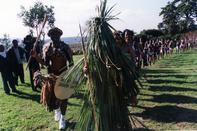Transition from Childhood to Adulthood
In the past Zulu traditional life was highly structured and discipline underlined its every facet. Each person had a place and specific functions to perform, depending on gender, and age and rank in the homesteads 'umuzi'.

Distinction between members of the umuzi was reinforced by the fact that every individual passed through a number of well-marked stages, none of which could be entered into without preparation and ceremony. The first stage in the transition from childhood to adulthood was marked by the qhumbuza or ear-piercing ceremony, which every child had to undergo before reaching puberty.
The next stage in the life of the individual was the attainment of physical maturity, or puberty. In early times, this was the occasion for an important initiation ceremony called the thomba, which applied equally to boys and girls.
During the initiation process, boys and girls of the same age went into separate seclusion, where they were taught by instructors on the requirements and duties of adulthood. The period of seclusion was done away with after the introduction of the amabutho 'age-based regiments' system in the late 18th century.
After the male thomba ceremony, the young boy was called an insizwa 'young man' and he was free to court girls of his age and in his group, but he was not free to marry. Two further rites of passage had to be performed before this was possible.
The first was his incorporation into a regiment, or ibutho, which could involve as many as 10 years of service to the king. The second was the sewing on of the isicoco or head-ring, which signified the attainment of full adulthood.
The Reed Ceremony

The Reed Ceremony, which aims to inculcate a sense of pride in young women, has become a major event, attended by girls from the entire KwaZulu- Natal region. Since 1994, when the African National Congress came to power, attempts have been made to transform this ceremony into a multi-cultural event, but these have not been entirely successful.
Young women also have coming-of-age ceremonies 'umemulo'. At these, the woman's family slaughters an ox from which she obtains a caul of fat which she wears while dancing for the assembled guests This fat symbolizes the protection her ancestors will afford her when she leaves her home to marry and live in another homestead.